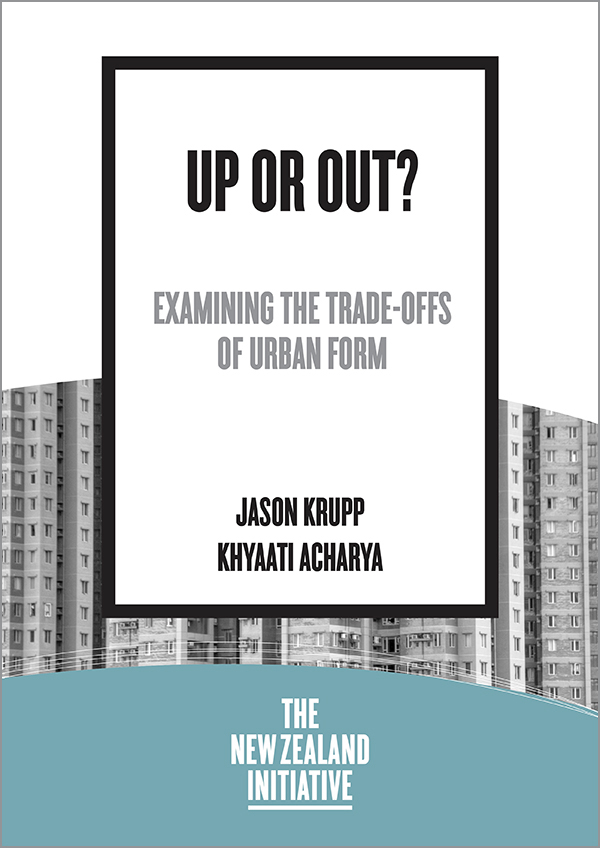With a greater number of local government bodies having adopted a compact city development strategy, or in the process of considering it, The New Zealand Initiative set out to examine whether these urban forms deliver on their stated benefits. The compact city school of thought is built on the belief that cities should be sustainable in their use of resources, and while this takes many policy forms, it is principally expressed in restricting the outwards spread of the urban footprint. In short, compact cities seek to build up, instead of out.
The theory holds that by increasing urban density, land will be used with greater efficiency and more housing will be built closer to areas of recreation and work. In short, compact cities seek to solve the problems of the modern city: unaffordable housing; costly infrastructure provision; and high pollution and congestion levels, all the while making urban centres more accessible and better places to live.
However, in our report, Up or Out? Examining the Trade-offs of Urban Form, an examination of the historical and academic record shows that this planning philosophy very seldom (if ever) delivers on its stated aims.
Land and infrastructure
Reducing the size of the urban footprint is desirable from a local government perspective because it:
- reduces the size of the infrastructure and utility networks, while spreading the costs across a greater concentration of taxpayers
- lowers infrastructure costs. This is important as many councils are faced with an increasing number of ratepayers on fixed incomes who are resistant to rate increases.
However, in order to achieve this, councils have to resort to more onerous planning rules and processes to restrict the urban footprint, and hence land supply. This comes with a number of economic trade-offs. The research found:
- zoning restrictions, such as urban limits, have been quantifiably shown to increase land supply shortages and dramatically reduce housing affordability. According to Demographia, the three least affordable cities in the world are the compact cities: Hong Kong, Vancouver and San Francisco.
- New Zealand’s main cities are characterised by severely unaffordable housing markets, with Auckland particularly unaffordable due to urban growth constraints and inner-city height limits.
- high land costs in ‘superstar cities’ have been shown to create a property inflation cycle where prices exceed wage growth, only affordable for wealthy residents, forcing lower income residents from the inner city.
- all urban residents share the cost of land prices in rent and mortgage costs, not just property owners, as businesses have to pass on higher operating expenses through prices.
- far less restrictive planning regimes in the United States and Europe have consistently nurtured affordable housing markets for decades.
Transport
Congestion represents a major drag on the productivity and liveability of a city. Proponents of compact cities argue the obvious solution is to invest in public transport infrastructure as a means of reducing the number of private motor vehicles. Again the historical and academic record show this fails to stack up because:
- US cities that have chosen to pursue compact development strategies tend to be more congested than dispersed urban environments (urban areas in North America most resemble New Zealand cities).
- research by the Reason Foundation, which quantitatively analysed 74 US metros over a 26-year period, found investments in public transit systems had little impact on overall traffic congestion.
- public transit, such as buses and trains, cannot replace the utility of cars for groups in society who have needs that extend beyond public transport routes, such as young families, working mothers and those who don’t work in the CBD (87 per cent of Auckland’s working age population are not employed in the inner city).
Agglomeration
It is well established that cities tend to be more economically efficient than non-urban areas when measured by wages and productivity. These are called agglomeration benefits, or the positive spill-over effects that come from positioning firms and workers closer together. Advocates for compact cities have taken this as support for the measures to increase population density. However, the report shows:
- prominent urban economists, both internationally and in New Zealand, remain cautious about correlating population density and productivity together. The emerging literature on the topic agrees that they occur, not why they occur.
- should the population-productivity relationship exist, work by Motu Economic and Policy Research in New Zealand suggests dramatic increases in density would yield only marginal increases in productivity. Auckland’s population would have to double (100 per cent increase) to lift productivity 6.9 per cent.
- economic research in Europe shows negative spill-over effects from higher population densities can eclipse the benefits of agglomeration. This was seen in the Netherlands, where outlying regions saw greater productivity growth than urban areas (often cited as ideal examples of compact development) due in part to higher congestion in cities.
Health
Compact cities with high levels of walking, cycling, and transit use are presumed to offer health benefits to residents. It is a fact that higher levels of activity do lead to improved health outcomes. But establish a case for costly urban form changes to achieve these benefits is problematic because:
- there is a weak relationship between high population densities and low obesity rates.
- some of the world’s most dense and compact cities in Asia are struggling with obesity epidemics similar to that of their Western counterparts, despite high levels of walking, cycling and public transit
- landscape and climate have a bigger influence over walking and cycling activity levels than urban form.
- quantitative research in Vancouver, a compact city, shows urban areas with high walkability are exposed to significantly higher primary pollutants than suburban areas.
- green spaces and vegetation within cities, proven to provide health benefits, are likely to decline as population densities increase, particularly gardens, parks and playgrounds.



